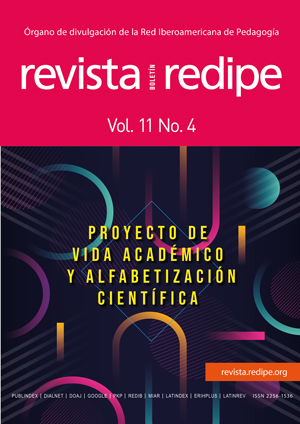Disjunction between places and non-places: Sentimenting the teaching of social sciences in a context of pandemic and virtuality: The virtual classroom, a non-place? (Theoretical reflections based on Simmel, Camus and Augé)
Main Article Content
Keywords
Non-place, Social Sciences, Higher education, Pandemic, Virtuality
Abstract
The feeling of “strangeness” and non-belonging have been topics addressed by authors such as the German philosopher and sociologist Georg Simmel, and by the writer, also a French philosopher, Albert Camus. It is considered that the speculations of both can be categorized in the notion of non-place, raised by the French anthropologist Marc Augé, who proposes that a non-place “cannot be defined either as a space of identity neither as relational nor as historical” (Augé, 2000, p. 44); with this definition, it is evident that Augé intends to explain that all those places in which there is no symbolic interaction or in which there is no collective construction of shared identity, are non-places.
The analytical category of non-places that refers to feeling “alien”, “foreign”, allows us to analyze one of the current consequences of life, in the midst of a context of pandemic and virtuality that, among other areas of daily life, has permeated education.
For the above, it is considered essential to collect the perceptions, sensations, emotions and conditions experienced by second-year higher education students, from two different careers and universities in Guatemala; this, with the aim of evidencing how the context of pandemic and virtuality has modified the classroom in a non-place, exposing how the constitution of the classroom in a non-place can affect the teaching of Social Sciences.
The theoretical foundation of the approaches, based on the authors mentioned in advance and the methodological support, will consist of the application of the qualitative method accompanied by techniques such as: surveys and interviews.
References
Buchenhorst, R. (2016). Capítulo 8. Digresión sobre el extranjero. La contribución de Georg Simmel a la Sociología de la migración. En Georg Simmel, un siglo después. Actualidad y perspectiva. Vernick, E. et.al. (editores). Ciudad Autónoma de Buenos Aires, Universidad de Buenos Aires: Instituto de Investigaciones Gino Germani – UBA. 133-147.
Camus, A. (2016). Obras Maestras. México D.F.: Editores Mexicanos Unidos, S.A
Entwistle, J. (2002). El cuerpo y la moda. Una visión sociológica. Barcelona: Paidós.
Greene, R. (2005). La metrópolis y la vida mental. Georg Simmel. Bifurcaciones Revista de Estudios Culturales Urbanos, (4), http://www.bifurcaciones.cl/2005/09/lametropolis-y-la-vida-mental/
Lezama, J.L. (2002). Teoría social, espacio y ciudad. México: El Colegio de México, Centro de Estudios Demográficos y de Desarrollo Urbano.
Palacios, R. (2005). La metrópolis como cultura material. La metrópolis y la vida mental como propuesta metodológica. Bifurcaciones Revista de Estudios Culturales Urbanos, (4), http://www. bifurcaciones.cl/2005/09/la-metropoliscomo-cultura-material/
Sabido Ramos, O. (2016). Capítulo 9. Alcances teórico-metodológicos de la Sociología relacional de Georg Simmel. El caso reciente de la Sociología de los sentidos. En Georg Simmel, un siglo después. Actualidad y perspectiva. Vernick, E. et.al. (editores). Ciudad Autónoma de Buenos Aires, Universidad de Buenos Aires: Instituto de Investigaciones Gino Germani –UBA. 149- 165.
Sabido Ramos, O. (2017). Georg Simmel y los sentidos: una sociología relacional de la percepción. Revista Mexicana de Sociología 79(2), 373- 400. DOI: http://dx.doi.org/10.22201/ iis.01882503p.2017.2
Simmel, Georg (2008). Pedagogía escolar. Barcelona: Gedisa.
Simmel, G. (2014). Digresión acerca de la comunicación escrita. En Sociología: estudios sobre las formas de socialización. México: Fondo de Cultura Económica. 405-407.
Simmel, Georg (2014). Digresión sobre la sociología de los sentidos. En Sociología: estudios sobre las formas de socialización. México: Fondo de Cultura Económica. 622-637.
Simmel, G. (1986). La significación estética del rostro. En El individuo y la libertad. Ensayos de crítica de la cultura. 187- 192.
Simmel, G. (1977). Filosofía del dinero. Trad. García Cotarelo. Madrid: Instituto de Estudios Políticos.
Vernik, E. (2016). Capítulo 1. Visiones de la libertad. Acerca de la cuestión central en Simmel. En Georg Simmel, un siglo después. Actualidad y perspectiva. Vernick, E. et.al. (editores). Ciudad Autónoma de Buenos Aires, Universidad de Buenos Aires: Instituto de Investigaciones Gino Germani – UBA. 21 – 35.
Villalvazo Sánchez, O. (2015). El extranjero de Camus: algo más que el absurdo. Sincronía. Revista de Filosofía y Letras, (68), 74 – 92.



